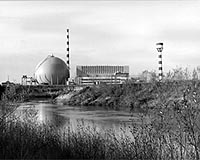 |
Washington (AFP) April 11, 2010 In a strange twist of Cold War enmity on the melt, uranium from what once were Russian nuclear warheads is used to heat and light American homes, thanks to the Megatons to Megawatts Program -- a successful example of nuclear non-proliferation. The 20-year agreement was signed back in 1994 between Russia and the United States. "Megatons to Megawatts is the most successful non-proliferation program in history," argues Philip Sewell, senior vice-president at USEC, a private US company that runs the agreement that turns highly enriched uranium into lightly enriched uranium. After the collapse of the Berlin Wall and the Soviet Union, the administration of George H.W. Bush started negotiating how to get rid of stocks of nuclear arms dismantled in the former Soviet Union. In 1994, the United States and Russia cut a practical-minded deal to turn 500 metric tonnes of highly enriched uranium, the equivalent of 20,000 nuclear warheads, into weakly enriched uranium that could be used in US nuclear power plants. The deal so far has made it possible to reprocess 15,000 nuclear warheads stockpiled in the Russian federation, Ukraine and Kazakhstan between 1950-1987. When it expires in 2013, the program will have handled 20,000 nuclear warheads, and supplied the United States with about 10 percent of its annual power use, or half of its nuclear energy. It is no small contribution to cleaning up weaponry, and "this material represents the equivalent amount of energy, or of electricity that would power the world for about six months, the United States for about two years, and France for 15 years," Sewell explains. And USEC, which does two billion dollars in business annually with 3,200 employees in the uranium enrichment industry, acknowledges making a "small profit" along the way. Over two decades, the operation will have had a total budget of eight billion dollars and will have sent back about 500 million dollars to the Russians, Sewell said. The US company pays for the uranium to be treated, which is done in Siberia, and the long 1.5 tonne cylinders turned back into fuel are shipped by boat from St. Petersburg to Kentucky where USEC has its conversion facility. USEC then supplies the specially prepared fuel to operators of the 104 US nuclear reactors. With an international summit on nuclear security looming for Monday and Tuesday in Washington, Sewell is hopeful that the program will get a new lease on life. "Whatever happens, we are fully prepared to support any continuation of the program," he said. As a counterpoint, he noted that only 700 nuclear warheads are expected to be destroyed under the new START (Strategic Arms Reduction Treaty) signed Friday in Prague.
Share This Article With Planet Earth
Related Links Nuclear Power News - Nuclear Science, Nuclear Technology Powering The World in the 21st Century at Energy-Daily.com
 France, Italy boost nuclear cooperation, defend euro
France, Italy boost nuclear cooperation, defend euroParis (AFP) April 9, 2010 France and Italy on Friday agreed to cooperate more closely to increase nuclear power generation and vowed to come to the aid of debt-laden Greece in order to defend the euro. At a summit at the Elysee presidential palace, President Nicolas Sarkozy praised Italy's decision to tap into nuclear power and said France was ready to share its expertise as Europe's largest atomic energy producer. ... read more |
|
| The content herein, unless otherwise known to be public domain, are Copyright 1995-2010 - SpaceDaily. AFP and UPI Wire Stories are copyright Agence France-Presse and United Press International. ESA Portal Reports are copyright European Space Agency. All NASA sourced material is public domain. Additional copyrights may apply in whole or part to other bona fide parties. Advertising does not imply endorsement,agreement or approval of any opinions, statements or information provided by SpaceDaily on any Web page published or hosted by SpaceDaily. Privacy Statement |